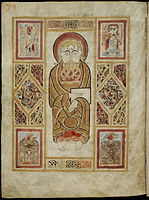
The Book of Kells is an illuminated manuscript Gospel book in Latin, containing the four Gospels of the New Testament together with various prefatory texts and tables. It was created in a Columban monastery in either Ireland, Scotland or England, and may have had contributions from various Columban institutions from each of these areas. It is believed to have been created c. 800 AD. The text of the Gospels is largely drawn from the Vulgate, although it also includes several passages drawn from the earlier versions of the Bible known as the Vetus Latina. It is regarded as a masterwork of Western calligraphy and the pinnacle of Insular illumination. The manuscript takes its name from the Abbey of Kells, County Meath, which was its home for centuries.
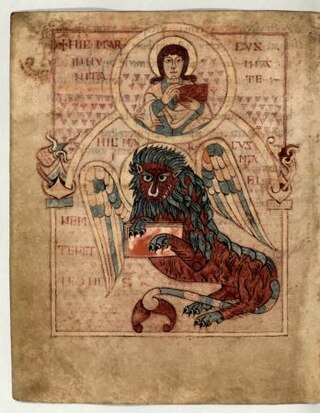
The Book of Cerne is an early ninth-century Insular or Anglo-Saxon Latin personal prayer book with Old English components. It belongs to a group of four such early prayer books, the others being the Royal Prayerbook, the Harleian prayerbook, and the Book of Nunnaminster. It is now commonly believed to have been produced sometime between ca. 820 and 840 AD in the Southumbrian/Mercian region of England. The original book contains a collection of several different texts, including New Testament Gospel excerpts, a selection of prayers and hymns with a version of the Lorica of Laidcenn, an abbreviated or Breviate Psalter, and a text of the Harrowing of Hell liturgical drama, which were combined to provide a source used for private devotion and contemplation. Based on stylistic and palaeographical features, the Book of Cerne has been included within the Canterbury or Tiberius group of manuscripts that were manufactured in southern England in the 8th and 9th centuries AD associated with the Mercian hegemony in Anglo-Saxon England. This Anglo-Saxon manuscript is considered to be the most sophisticated and elaborate of this group. The Book of Cerne exhibits various Irish/Celtic, Anglo-Saxon, Continental, and Mediterranean influences in its texts, ornamentation, and embellishment.

British Library, Add MS 40618 is a late 8th century illuminated Irish Gospel Book with 10th century Anglo-Saxon additions. The manuscript contains a portion of the Gospel of Matthew, the majority of the Gospel of Mark and the entirety of the Gospels of Luke and John. There are three surviving Evangelist portraits, one original and two 10th century replacements, along with 10th century decorated initials. It is catalogued as number 40618 in the Additional manuscripts collection at the British Library.

British Library, Egerton MS 609 is a Breton Gospel Book from the late or third quarter of the ninth century. It was created in France, though the exact location is unknown. The large decorative letters which form the beginning of each Gospel are similar to the letters found in Carolingian manuscripts, but the decoration of these letters is closer to that found in insular manuscripts, such as the Book of Kells and the Lindisfarne Gospels. However, the decoration in the Breton Gospel Book is simpler and more geometric in form than that found in the Insular manuscripts. The manuscript contains the Latin text of St Jerome's letter to Pope Damasus, St. Jerome's commentary on Matthew, and the four Gospels, along with prefatory material and canon tables. This manuscript is part of the Egerton Collection in the British Library.
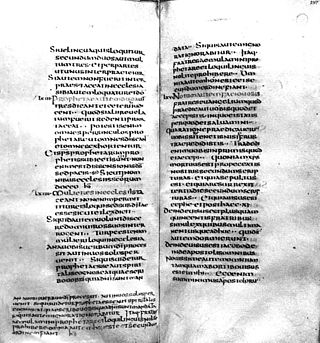
The Codex Fuldensis, also known as the Victor Codex, designated by F, is a New Testament manuscript based on the Latin Vulgate made between 541 and 546. The codex is considered the second most important witness to the Vulgate text; and is also the oldest complete manuscript witness to the order of the Diatessaron. It is an important witness in any discussion about the authenticity of 1 Corinthians 14:34-35 and the Comma Johanneum. It is one of the earliest dated manuscripts of the New Testament. It was corrected until 2 May, 546 AD.

Codex Boernerianus, designated by Gp, G3 or 012 (in the Gregory-Aland numbering of New Testament manuscripts), α 1028 (in the von Soden numbering of New Testament manuscripts), is a small New Testament codex, measuring 25 x 18 cm, written in one column per page, 20 lines per page. Using the study of comparative writing styles (paleography), the manuscript has been dated to the 9th century CE. The name of the codex derives from the theology professor Christian Frederick Boerner, to whom it once belonged. The manuscript has several gaps.

The Abbey Library of Saint Gall is a significant medieval monastic library located in St. Gallen, Switzerland. In 1983, the library, as well as the Abbey of St. Gall, were designated a World Heritage Site, as “an outstanding example of a large Carolingian monastery and was, since the 8th century until its secularisation in 1805, one of the most important cultural centres in Europe”.

Codex Sangallensis, designated by Δ or 037, ε76, is a Greek-Latin diglot uncial manuscript of the four Gospels. Using the study of comparative writing styles (palaeography), it is usually dated to the 9th century CE, though a few palaeographers would place it in the 10th century CE. It was given its current name by biblical scholar Johann Martin Augustin Scholz in 1830.
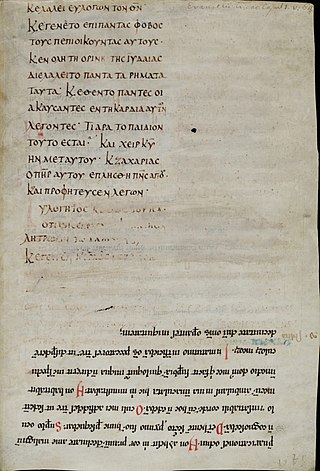
Uncial 0130, ε 80 (Soden), is a Greek uncial manuscript of the New Testament, dated palaeographically to the 9th-century. Formerly it was labelled by Wc.
Codex Sangallensis is the designation of codices housed at the Abbey library of Saint Gall in St. Gallen. The codices are index with a continuous arabic number, many of the codices have been digitized through the e-codices project in Switzerland with over 2000 of them freely available online.
The Codex Sangallensis 60, designated by 47 on the Beuron system, is an 8th-century Latin manuscript of the New Testament. The text is written on vellum. The manuscript contains the text of the Gospel of John 1:29–3:26 on 35 parchment leaves. It contains the Ammonian Sections and Eusebian Canons; it uses abbreviations.

Codex Sangallensis 1395 is a nineteenth-century compilation of fragments, and includes a 5th-century Latin manuscript of the New Testament, designated by Σ. The text, written on vellum, is a version of the Latin Vulgate.

The Codex Sangallensis 63, designated by S in some critical editions of the Bible, is a 9th-century Latin manuscript of the New Testament. The text, written on vellum, is a version of the Vulgate and contains the text of the Acts of the Apostles, Epistles, Book of Revelation, and non-biblical material. The manuscript has not survived in a complete condition, some parts of it have been lost. The original manuscript did not contain the Comma Johanneum, but it was added by a later hand on the margin.

The Codex Sangallensis 907, designated S, is an 8th-century Latin manuscript of the New Testament. The text, written on vellum, is a version of the Latin Vulgate Bible. It contains the text of the Catholic epistles, Book of Revelation, and non-biblical material. The manuscript did not survived in a complete condition and some parts of it has been lost. The codex contains the Comma Johanneum.

The Lindau Gospels is an illuminated manuscript in the Morgan Library in New York, which is important for its illuminated text, but still more so for its treasure binding, or metalwork covers, which are of different periods. The oldest element of the book is what is now the back cover, which was probably produced in the later 8th century in modern Austria, but in the context of missionary settlements from Britain or Ireland, as the style is that of the Insular art of the British Isles. The upper cover is late Carolingian work of about 880, and the text of the gospel book itself was written and decorated at the Abbey of Saint Gall around the same time, or slightly later.

The Golden Psalter of St. Gall is a Carolingian Gallican psalter produced in the late 9th century, probably begun in West Francia, later continued in St. Gall Abbey.
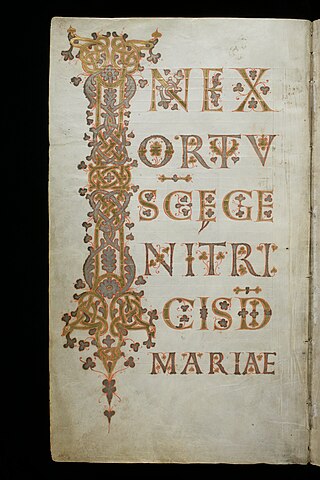
The Evangelium longum is an illuminated manuscript Latin evangeliary that was made around 894 at the Abbey of Saint Gall in Switzerland. It consists of texts drawn from the Gospels for the use of the preacher during Mass.
The St. Gall Priscian Glosses, abbreviated Sg., is an Irish manuscript of the Latin grammar Institutiones grammaticae by Priscian, held by the Abbey Library of St. Gall. It contains 9412 glosses, including 3478 in Old Irish. Together with the Würzburg glosses on the Epistles of St Paul and the Milan glosses on a Commentary on the Psalms they provide the main source of Old Irish writing available today and thus serve as an important reference for linguistic research on Old Irish.

The Codex Sangallensis 484 is an early medieval music manuscript, produced in the abbey of St. Gallen and stored in the Abbey Library in St. Gallen. The manuscript is known for its exhaustive collection of so-called tropes, meaning melodic or textual extensions to previously existing liturgic chants. As this particular manuscript is among the most extensive collections of such tropes from the eastern Frankish kingdom, it plays an important role in the history of music.

The Codex Sangallensis 381 is an early medieval music manuscript, produced in the abbey of St. Gallen and stored in the Abbey Library in St. Gallen. The manuscript is known for its exhaustive collection of so-called tropes, verses, and sequences. Together with the Cod. Sang. 484, this manuscript makes an important contribution to one of the most exhaustive collections of such compositions in the East Frankish kingdom and thus plays an important role in the history of music.



